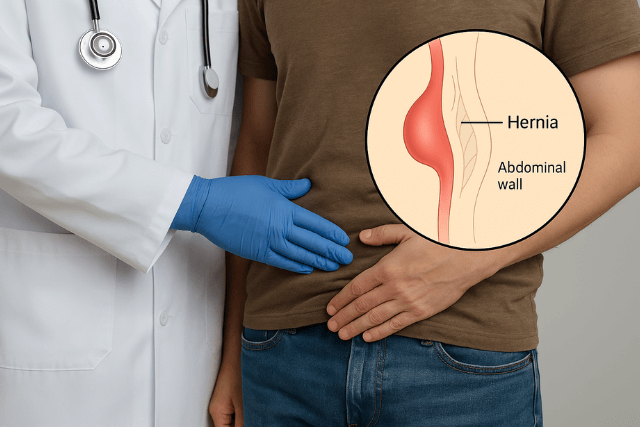Hernias are common health issues that affect many people. When part of an organ or tissue pushes through a weak spot in the muscle wall, a hernia forms. Often, it causes pain or discomfort. Therefore, understanding hernia causes, recognizing symptoms, and finding the right treatment matter a lot.
Types of Hernia
Inguinal hernia?
What is an inguinal hernia?
An inguinal hernia appears when fatty tissue or part of the intestine bulges through a weak spot in the lower abdominal wall. This usually happens near the inguinal canal, which lies in the groin area. It is the most common hernia type in all genders, but men get it far more often.
Causes
- Weak spot in abdominal wall: It may result from congenital weakness or strain.
- Heavy lifting or straining: When you lift heavy weights or push hard, pressure increases inside the abdomen.
- Chronic cough or constipation: Both can raise pressure and push organs out.
- Pregnancy or obesity: These conditions strain the abdominal wall.
Symptoms
- A bulge in the groin that becomes more obvious when standing or coughing
- A dull ache or sharp pain in the groin or scrotum next to the bulge
- A feeling of heaviness in the groin
- Hernia symptoms signs often appear gradually and worsen over time
Diagnosis
A doctor will examine the groin area, feel for any bulge, and ask you to cough or stand. They may suggest an ultrasound or CT scan to confirm what type it is.
Treatment and Hernia Repair Options
Watchful waiting
If the hernia is small and causes little or no pain, the doctor may advise monitoring it. Yet, this approach requires regular check-ups, because the hernia can grow or cause complications.
Hernia surgery
When the hernia causes discomfort or grows, surgery is usually the best treatment. Active voice dominates here.
- Open repair: The surgeon makes a small cut, pushes the hernia back, and places a mesh to strengthen the weakened area. As a result, you get a more secure repair.
- Laparoscopic repair: The surgeon makes a few small cuts, uses a tiny camera, and places a mesh through ports. This method often means faster recovery and less pain.
Your hernia repair options depend on your age, health, hernia size, and your surgeon’s advice.
Recovery and Hernia Recovery Time
After surgery, you will likely feel better in 1 to 2 weeks. Full recovery takes about 4 to 6 weeks. Make sure to:
- Avoid heavy lifting for several weeks
- Gradually return to regular activities
- Follow doctor’s instructions on pain management and exercises
Hiatal hernia
What is a hiatal hernia?
A hiatal hernia occurs when part of your stomach bulges up into the chest through the diaphragm. It often leads to acid reflux and heartburn, as stomach acid spills into the esophagus.
Causes
- Pressure increases in the abdomen: From obesity, pregnancy, or coughing
- Weak diaphragm muscle: It can be congenital or develop with age
- Age-related changes: The diaphragm opening may widen as you get older
Symptoms
Hiatal hernia symptoms signs can include:
- Heartburn or acid reflux
- Regurgitation of food or acid
- Chest pain or discomfort
- Trouble swallowing
- Feeling full after eating small amounts
You may not notice symptoms if your hernia is small. However, many people report frequent heartburn and regurgitation.
Diagnosis
- A doctor may order tests like:
- Endoscopy: To look inside your esophagus and stomach
- Barium swallow X-ray: To show the hernia clearly
- Esophageal manometry: To measure muscle and acid movement
Treatment and Hernia Repair Options
Lifestyle changes
First, many experts will recommend:
- Eating smaller meals
- Avoiding foods that trigger reflux (e.g., spicy or fatty foods)
- Losing weight if needed
- Waiting until food moves through your stomach before lying down
These hernia prevention tips often help ease symptoms.
Surgery
If lifestyle changes and medications don’t work:
- Fundoplication surgery: The surgeon wraps the upper part of your stomach around the lower esophagus and, consequently, improves the diaphragm opening.
- Mesh placement: In more complex cases, a mesh may strengthen the diaphragm.
Most patients recover in 2 to 4 weeks, depending on hernia size and procedure type.
Umbilical hernia
What is an umbilical hernia?
An umbilical hernia happens when fatty tissue or part of the intestine pushes through a weak spot near the belly button. It is common in infants but also occurs in adults.
Causes
- Congenital weakness: In infants, the abdominal wall near the umbilical cord may not close fully.
- Obesity or pregnancy: These conditions stress the abdominal wall.
- Chronic cough or straining: They can weaken the belly wall over time.
Symptoms
Signs of an umbilical hernia include:
- A soft bulge around the belly button
- Bulge that becomes larger when the baby cries or when you cough or strain
- Mild discomfort or pain in some cases
In adults, this hernia may cause more obvious bulges and discomfort.
Diagnosis
A doctor can see and feel the bulge. They may call for an ultrasound in some adult cases to rule out complications.
Treatment and Hernia Repair Options
Observation
In infants, small hernias often close on their own by age 2. Sometimes, doctors advise waiting unless there are symptoms.
Surgery
When needed:
- The surgeon makes a small cut, pushes the hernia tissue back in, and stitches the hole closed. Adults might need mesh reinforcement.
- This is a safe, common procedure with low risk.
Recovery and Hernia Recovery Time
After surgery, most infants recover within a few days. Adults may recover in 1 to 2 weeks before returning to normal activity.
Femoral hernia
What is a femoral hernia?
A femoral hernia develops when tissue pushes through the femoral canal, which is the passageway just below the groin crease. As a result, it appears as a bulge in the upper thigh or groin area, near the leg.
Causes
- Weakness in the lower abdominal wall
- Strain due to heavy lifting, chronic cough, or constipation
- More common in women, especially after pregnancy or childbirth
Symptoms
- Symptoms of a femoral hernia include:
- A small lump near the groin crease or thigh
- Discomfort or pain, especially when standing, coughing, or straining
- In severe cases, the hernia can get stuck (“incarcerated”) or cut off blood flow (“strangulated”), raising the risk of emergency.
Diagnosis
A doctor exams the area and may request an ultrasound or CT scan to confirm.
Treatment and Hernia Repair Options
Surgery
Femoral hernia repair usually is needed promptly, due to risk of strangulation. Surgeons use:
- Open repair: They push the bulge back and reinforce with mesh.
- Laparoscopic repair: Small cuts plus camera help place mesh with less pain and faster healing.
Recovery and Hernia Recovery Time
After surgery, patients often resume daily activity within 1 to 2 weeks. In most cases, full recovery takes about 4 weeks with light activity. However, it may take longer if the patient needs to return to heavy lifting.
| Hernia Type | Location | Common in… | Main Symptoms | Repair Time |
|---|---|---|---|---|
| Inguinal hernia | Groin | Men | Groin bulge, pain when lifting or coughing | 4–6 weeks |
| Hiatal hernia | Diaphragm, chest area | Adults | Heartburn, reflux, chest pain | 2–4 weeks |
| Umbilical hernia | Belly button area | Infants, adults | Belly button bulge, mild discomfort | Few days (infants), 1–2 weeks (adults) |
| Femoral hernia | Upper thigh/groin crease | Women | Thigh/groin lump, discomfort when standing | 4 weeks |
Prevention Tips for All Hernia Types
Preventing hernias is possible in many cases, especially when you make small but consistent lifestyle changes. Although some hernia types may occur due to genetics or birth defects, many others develop from repeated strain or pressure on the abdominal wall. Therefore, taking proactive steps can go a long way in protecting your body from hernia-related problems.
Here are practical and evidence-based hernia prevention tips that apply to all hernia types:
Maintain a healthy weight:
Carrying extra weight adds strain to your abdominal muscles and weakens the muscle wall over time. As a result, the chances of developing a hernia increase. By eating a balanced diet and staying active, you keep your weight in a healthy range, therefore reducing unnecessary pressure.
Lift objects the right way:
Lifting heavy objects improperly is one of the most common triggers for hernias. To prevent injury, always bend at your knees not your waist and keep the object close to your body. Additionally, avoid twisting while lifting, and ask for help when needed. Proper technique supports your core and reduces abdominal stress.
Manage chronic cough or constipation:
Ongoing coughing or frequent straining during bowel movements can build up internal pressure. Over time, this pressure may lead to a hernia. Therefore, it’s essential to treat the root causes. Use medications or lifestyle changes to manage a persistent cough. Likewise, increase fiber and fluids in your diet to improve digestion and ease bowel movements.
Strengthen your core muscles safely:
A strong core stabilizes your entire abdominal wall. However, not all exercises are safe if you’re at risk of a hernia. Choose low-impact workouts like walking, swimming, or guided abdominal exercises that do not involve intense straining. In addition, gradually building strength helps your body handle daily physical stress more effectively and without injury.
Eat more fiber-rich foods:
A fiber-rich diet prevents constipation and straining during bowel movements, both of which are known risk factors for hernia development. Include whole grains, fruits, vegetables, beans, and nuts in your meals. Moreover, drinking plenty of water helps your digestive system work more efficiently.
In conclusion, following these prevention tips can significantly reduce your risk of developing any of the types of hernia: whether it’s inguinal, umbilical, hiatal, or femoral. Making small adjustments in how you move, lift, eat, and exercise helps you avoid the physical stress that leads to hernias. Most importantly, if you already have symptoms or a history of hernias, talk to your healthcare provider about safe activities and personalized prevention strategies.
FAQs (Frequently Asked Questions)
Q: Can hernias heal without surgery?
A: Some small inguinal or umbilical hernias may stay stable, but they won’t heal on their own. Surgery often gives the best long-term solution.
Q: Is mesh safe in hernia repair?
A: Yes. Surgical mesh has improved over time and is now safe and effective. Mesh supports the repair and reduces recurrence risk. Discuss benefits and risks with your doctor.
Q: What if a hernia gets stuck?
A: That is called an incarcerated hernia. It can block blood flow and require emergency surgery. If you notice sudden pain, nausea, vomiting, or redness, seek medical help immediately.
Q: Are children at risk for hernias?
A: Yes, especially for umbilical and inguinal hernias. Most close on their own, but some need surgery.
Q: Can exercise cause hernia?
A: Improper heavy lifting or straining can contribute to hernia development. However, by using proper form and avoiding extreme strain, you can build core strength and, as a result, lower your risk of developing a hernia.
Conclusion
Understanding Types of Hernia: helps you act early recognize symptoms, weigh treatment options, and prevent future issues. This blog used simple language, active voice, and clear headings to guide you through each hernia type, its cause, symptoms, and treatment steps. By following hernia repair options, hernia symptoms signs, hernia prevention tips, and understanding hernia recovery time, you can stay informed and take control of your health. If you suspect a hernia, talk to a trusted doctor for the best care plan.
Thank you for reading. If you found this helpful, feel free to share with someone who might benefit. Your best health starts with knowledge.










